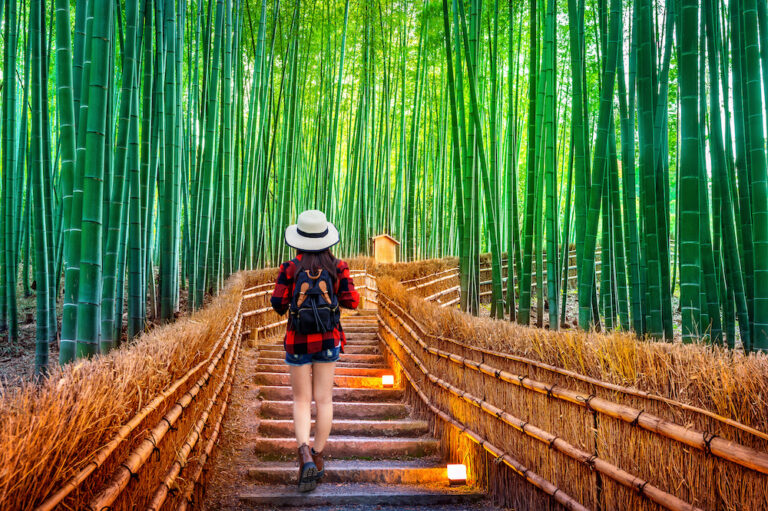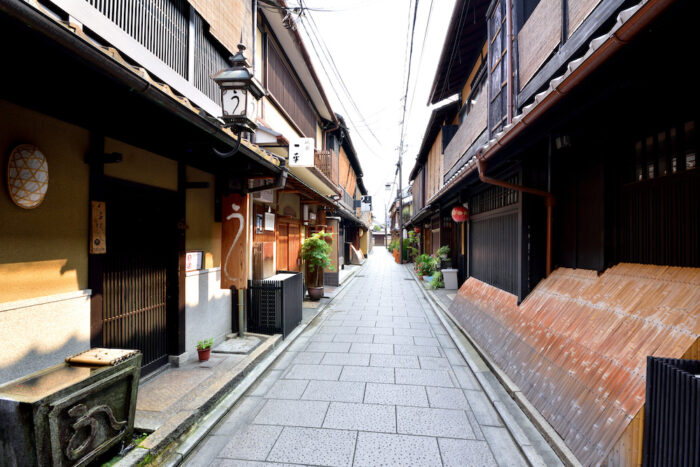For more than 1200 years, from the move of the capital to Kyoto in 794 until the 20th century, a splendid, delicate and unique culture originated that is considered the mother culture of Japan. This is why Kyoto is often called “the heart of Japan” and it is said that it would be impossible to get to know the country without visiting this wonderful city. It is easy to create an itinerary that contains both highlights and hidden spots.
Many of its temples were founded about a thousand years ago but have been destroyed by earthquakes, fires, and wars, to be rebuilt again and again. Because of its historical significance, the city was spared most bombing during WW2, making it one of the few major Japanese cities with still plenty of traditional cityscape intact.
Kyoto has always been the Imperial capital of Japan. Considering all the beautiful sights, the emperors have done their best to give the city an imperial status. Everywhere you will find temples, palaces, and beautiful gardens. This in combination with the beautiful location of Kyoto (it is located in a valley) gives the city a spectacular view.
There are many ways to enjoy the unique features of this historic city, its architecture, gardens, Buddhist traditions, festivals, Kaiseki ryori (Japanese-style course meal), tea ceremony, arts, and crafts. One of the best ways to tour the city is by walking and trying to get off the beaten track. What is the best itinerary for those only staying for a short time, looking to experience the best highlight in combination with some undiscovered treasures?
Tour Kyoto Highlights

If you only have limited time, these are the 5 highlights we recommend you to see in Kyoto. To help you plan your day, we mentioned for each sight in which part of the city it is located.
- (NORTH-WEST) Start with the most famous temple in the city, maybe of all of Japan. This pavilion is also called The Golden Pavilion. It owes its name to the fact that the walls, pillars, and roof are covered with gold leaf. The building is a replica of the original pavilion from the 12th century. The original building was set on fire in 1950 by monk Hayashi Shoken. The pavilion was rebuilt and in addition to the top floor, the walls and pillars on the second floor were covered with gold leaf. The Kinkaku-Ji has been on the UNESCO World Heritage List since 1994.
- (CENTRAL-EAST) In terms of location, perhaps the most beautiful temple in Kyoto. The Kiyomizudera Temple is also called ‘The Temple of Pure Water’. In the spring and autumn, the colors of the surrounding forests give the temple an even more beautiful image. The most impressive is the wooden frame on which the balcony of cherry trees and maples give the temple an even more beautiful view. For the most beautiful pictures, however, you must be at this temple in the evening! Keep in mind that this temple is very popular. If you do not want too many people around you go early in the morning or by closing time.
- (SOUTH-EAST) Do you know that famous picture of Japan with those red poles? That is the Fushimi Inari Taisha, one of Japan’s most famous and beautiful sanctuaries. Those thousands of poles are called torii gates. These gates together form a path of over four kilometers of land leading to the sacred mountain Inari. From here you have a beautiful view of Kyoto.
- (CENTRAL) The Gion district is the heart of Kyoto, the old center. It is Kyoto’s most famous geisha district, located around Shijo Avenue near the Yasaka Shrine and Kamo River. Here you will find stores, restaurants, and ochaya (teahouses). It is also the place to see geishas and maiko (geisha students). This region attracts tourists from all over the world and that is mainly because of the many traditional wooden machiya bargain houses. The houses are only five to six meters wide with narrow facades. Should you have the opportunity to visit this region in the evening. It is then extra atmospheric!
- (WEST) The Bamboo Forest is not located in Kyoto but in Arashiyama. Kyoto is however the place where most tourists visit this beautiful forest. The Bamboo Forest is a much-visited place. It is not very big but will leave a special impression on you! It is very quiet and you can take beautiful pictures. At the Bamboo Forest, you can follow workshops where you can make baskets, chopsticks, cups, and many more things that the Japanese use daily.
Hidden Gems of Kyoto

If you only have limited time, these are some off-the-beaten-path areas we recommend you to see in Kyoto. To help you plan your day, we mentioned for each sight in which part of the city it is located.
- (NORTH) One of the best places to experience Japanese culture in the bathhouse. The Japanese bathhouse culture is centuries old and originated in Kyoto. Here you will experience some of the more intangible aspects of Japanese culture, such as politeness and hygiene. Moreover, it is a wonderful way to relax. And with a bit of luck, you can have a chat with a local in the bath. In Kyoto, Funaoka Onsen is the place to go to experience a bath in Japanese. It is one of the oldest and most beautiful baths in the city and they are quite used to foreign visitors who don’t know exactly how everything works.
- (FAR-WEST) There is no direct bus to this location and you won’t find a description of it in your travel guide. There are hardly any other tourists. Temple Otagi Nenbutsu-ji is a hidden gem in Kyoto’s sea of sanctuaries. The temple Otagi Nenbutsu-Ji is hidden on the edge of the hilly and popular Arashiyama, in the southwest of Kyoto. The route to get there takes a winding mountain path through the wooded suburb. Along the way, you’ll pass teahouses and small village workshops housed in picturesque wooden houses.
- (FAR-WEST) For those who want to really go hiking, Kuya no Taki falls were named after the monk of more than 1000 years ago who founded the Rokuharamitsu-ji in Kyoto. The falls are a 40-minute hike from the Kiyotaki cable car station but worth it, and a nice spot for those with an interest in ascetic Buddhist practices.
- (NORTH-WEST) You can learn more about Japanese folklore and fairytales in Yokai street, not far from the Golden Pavillion. This typical traditional Japanese shopping street features many yokai, Japanese ghouls, monsters, and ghosts of old stories that are told to kids to scare them and keep them away from trouble. Not all yokai are necessarily evil although they do tend to look scary, and they are a part of growing up in Japan.
- (SOUTH) Anyone who loves sake should stop by the Fushimi Chushojima area when they are in Kyoto. This traditional sake district is real eye-candy with its old wooden houses and Cherrytree-lined waterfront. Sake is sold from traditional storefronts everywhere, and there is a museum where you can taste different types of sake.
Your Japan Tour
If you really want to get the most out of your visit to this city full of hidden gems and not only learn a lot more about its interesting history but also find hidden gems you can’t easily find on your own, booking a private guide may be one of the best ways to do so.
As seasoned Japan experts, we can help you create your perfect Japan tour, including destinations like Kyoto. Contact us to start planning your unforgettable holiday to this fascinating country full of once-in-a-lifetime experiences, culture, history, nature, and delicious food!